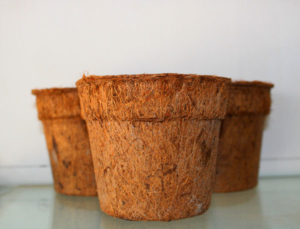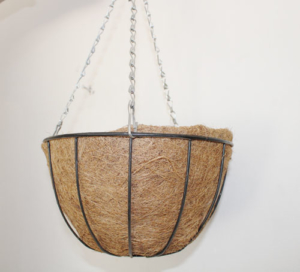COCO POTS
If you don’t know about the coco pots, you won’t probably know its use, when you don’t know its use, you probably won’t use it. So you must know about it now.

What are Coco pots?
- The coco pots are used to grow plants. The bigger size coco pots are used to grow larger plants in them.
- Coco pots are made up of coconut fibre which holds water for a longer duration. Also, gives way for the green products.
- They are very much eco-friendly and biodegradable.
- These are growing in demand as they maintain moisture and water retaining capacity. Advanced manufacturing techniques are used to ensure it durability and its quality.
- If its eco-friendly and biodegradable then it’s the need of the hour.
What is Coco coir and how is it made?
Coco-coir pots are made up of the coconut that is derived from the fibrous body between the husk and the coconut. These are biodegradable pots that are excellent growing medium because plants can be transplanted into the pot itself. Coco-coir pots have an exceptionally high permeability to water, air and roots.
The coir pots break down naturally in the soil, which minimises root disturbance at the time of planting. Gardeners looking for faster cultivation, an excellent root system and re-establishment without any shock from transplanting use Coco Coir Pot.

Benefits of coco pots
1. Water Holding Ability of Coco Coir:
Coco coir has excellent water holding capacity while still promoting good drainage and aeration. Unlike peat, moss coir is 100% biodegradable. As an average coconut tree produces 150 coconuts in a year, there is a continuous supply of coir. It is said that peat bogs take like 25 years to renew, while Coco coir is constant.
Coconut fiber has become a favored grow medium also because it prevents nutrients from leaching away.
2. Coco allows the roots to grow freely:
The texture of the coir pots allows the water and air to penetrate quickly.
Due to this, the roots can breathe, and there is no concussion of roots. Coir also helps in the diffusion of water and air, which helps the roots, to permeate the walls of the pots with complete ease.
3. Repotting or transplanting is very easy:
Simply dig and transplant the whole coco coir pot into the ground or re-pot it in a big container, without the hassle of coiling and tangling of roots. The pot will disintegrate all by itself. Isn’t that easy?
4. Beneficial pH Value:
pH value of coir is neutral i.e. between 5.2 and 6.8. On the contrary peat moss is considered acidic as its pH value is of 3.3 to 4. Thus, coco coir pots are ready to use for most plants without adding lime.
Nutritionally, coco coir is rich in potassium, iron, manganese, copper, and zinc. So, if you are growing hydroponically, you can consider using these pots as they can provide the correct balance of nutrients.
Secondly, Coir also has a high cation exchange rate that allows it to store various nutrients and release them as and when needed.
On the other hand, coir tends to hold on to calcium and magnesium; thus you will have to adjust your nutrient mix accordingly. Coir is also known to promote the growth of beneficial bacteria owing to its compounds called lignins.
When lignin’s are present, beneficial bacteria thrive, and bad ones are minimized. When coir is used in hydroponics, the beneficial microbes will be optimized.
TYPES OF COCO COIR
1. Garden Round Hanging Basket
These are hanging pots. Hanging baskets offer versatility in the presentation of your favourite flora allowing you to place it where you can enjoy it from your window or while you are working in your garden.
2. Coco nursery pot
Coco Nursery pot are made from coir fiber blended with natural rubber. Coir pots are 100 percent biodegradable and are used for horticulture. When plants grow in coir pots preserves roots from breaking and develops many tiny roots throughout the walls.
These coir pots retain water for a long time and act as organic nutrition to the plants.
3. Coir square pot
This one comes in many sizes.
This can carry large volume and larger plants can also be planted in these pots
Why do you need to change to eco-friendly?
I always buy containers made up of steel containers, though they weight slightly more and they cost a bit more because I am concerned with the health of my family.
But yet another reason to go eco-friendly is to be able to use organic fresh foods that will not be tampered with in any way.
There is absolutely no point in having an environmentally friendly product and filling it with junk food or meals that already contain certain chemicals and additives.
I know that you too, wouldn’t want to see your family members suffer from painful, life-threatening diseases because you didn’t make any changes.
Coco containers are perfectly eco-friendly and biodegradable.
Coco pots v/s Sand pots
Coco pots are way lighter than the sand pots. They are biodegradable and eco-friendly.
Plants grow faster in coco pots, as compared to the sand pots

COST OF THE COCO POTS
The cost of the coco pots isn’t very high, along with being eco-friendly it is also very pocket-friendly.
The prices range from rupees fifteen to rupees sixty depending upon its size and structure.
It also might be a good idea to purchase if you want it in the bulk quantity, these products are cheap.
There is also a huge range of options online, so you might buy it online as well.

Expanding Size and its Durability
Coco pots are also called natural gardeners.
Coir can resist compaction and breaking down and it can last as much as three times longer than peat moss. This should be considered when you look at the cost of coir versus peat moss.
Coir is actually comparable in price, but because it lasts longer, it may be the more economical choice. Shop around, though, as prices vary.

Its durability is high, lasts very long.
Flower Pots Hanger Garden Decoration Indoor and Outdoor Home
- There are several benefits of wanting a cocoa pot and decorating it in and outdoors
- • They also look good and Pots remain stable above ground for more than a year and biodegrade in the soil after 2 – 3 months.
- Plants benefit from air-pruning.
- Retains moisture for a longer time thereby reducing the frequency of watering. Moderates moisture and increase microbial activity. They act as root trainers, letting the root grow out of the pot.
- Avoids transplant shock to plant when plants are moved into the ground with the coir pot. Pots add texture to the soil as they degrade.
